In 2024, a computer graphics company called OTOY teamed up with the Roddenberry Archive to make a sanctioned, perhaps even canonical "Star Trek" short film called "765874 – Unification." The 11-minute short, directed by Carlos Baena and written by Jules Urbach, was released on the Roddenberry.x.io website on November 18, and many Trekkies were surprised to see the presence of notable actors such as William Shatner, Gary Lockwood, and Robin Curtis. Shatner and Lockwood were especially surprising, as Shatner is 93 years old, but looked exactly the same way he did in 1994 when he shot "Star Trek: Generations." Lockwood, 88, was de-aged to look like he did in his 1966 "Star Trek" episode "Where No Man Has Gone Before." At the end of the short, Leonard Nimoy, who died in 2015, was digitally resurrected for a brief encounter between Kirk and Spock.
![Holo Cameos] CINEMABLEND: "Star Trek's William Shatner Reveals He's Been Approached To Reprise Captain Kirk, And I Have A Theory About How The Character Could Return" | "Robert Picardo's return to Starfleet](https://external-preview.redd.it/holo-cameos-cinemablend-star-treks-william-shatner-reveals-v0-YnEnNWb9AIlhlTgiSf0EaCyklMIKPSGt73cBMRS6184.jpg?width=1080&crop=smart&auto=webp&s=0a3eb49b239da5f74bd790d442743384bd2c63b6)
"Unification" was the fourth of four such experimental digital shorts that served as a means to exploit new technologies in order to expand the "Star Trek" universe, but with avatars of the original actors. The four shorts, all under the "765874" title, attempted to expand established "Trek" canon into the realm of fan theories and expanded-universe novels using a clever combination of stock footage and digital recreations.
What are the 765874 Star Trek shorts?
The first of the shorts came about in 2022 when OTOY CEO Urbach and Gene Roddenberry's son Rod were conducting interviews for the Blu-ray release of "The Cage," the original "Star Trek" pilot episode. They had intended to interview actress Laurel Goodwin (who played the character Yeoman Colt in "The Cage"), but she passed away that February. The initial plan was to — just for fun, really — de-age Goodwin and place her on a digital version of the "The Cage" sets, making the interview look like it was a vintage conversation from the 1960s. They would be able to use Urbach's wife, Mahé Thaissa, as a stand-in model for Goodwin, as the two just happened to bear a canny resemblance.
Urbach and Roddenberry, however, came up with what they thought was a fun idea. Expounding on a 1998 "Star Trek" comic book called "Star Trek: Early Voyages," the pair came up with a short film featuring the Colt character (her officer's serial number was 765874), and starring Thaissa as the character's digital stand-in. The short featured Colt traveling through time and witnessing small snippets of "Star Trek" history, reaching an ineffable sense of nirvana as a result. The idea was that Colt had somehow evolved into an "Observer," a being that had an expansive, nonlinear view of history.
In the second short, called "765874 — Memory Wall" (2022), Thaissa returned to play Observer Colt, this time visiting the events of "Star Trek: The Motion Picture." The short expands on a passage from that film's novelization, which implied that Spock's mind-meld with the massive, all-encompassing machine V'Ger transformed the Vulcan into an Observer. He, too, now had an expansive view of history.
Actor Lawrence Selleck stood in for Leonard Nimoy. He wore prosthetics to match Nimoy's features, and his performance was "enhanced" by the OTOY team to make him look more realistically like Nimoy. (Yes, the filmmakers got permission from Nimoy's estate to do this.) The third short in the series, "765874 — Regeneration" (2023), was extrapolated from William Shater's 1995 novel "The Ashes of Eden," wherein Kirk was resurrected following the events of "Star Trek: Generations."
The story of 765874 - Unification
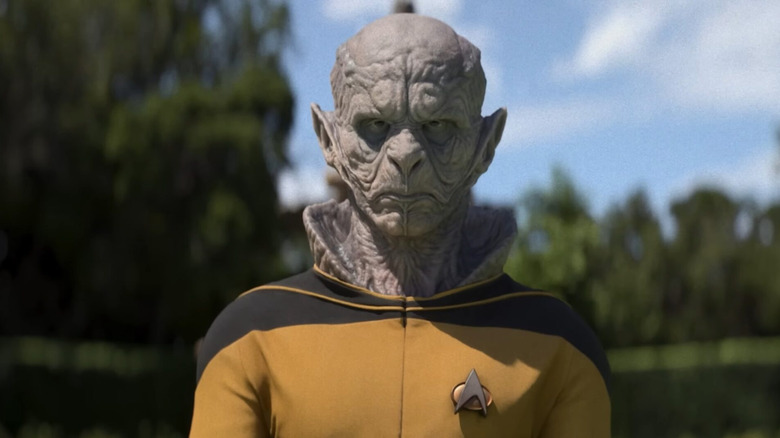
This brings us to "Unification," which is a vision of Kirk's afterlife. The short was born from many fans' frustrations over the circumstances of Kirk's death in "Generations" and Spock's death in "Star Trek Beyond." The two characters never got to give each other a proper sendoff.
The short sees Gary Mitchell using his godlike powers (acquired in "Where No Man Has Gone Before") to look into the future. He sees Kirk's death. Kirk, as old as he was in "Generations," awakens in a garden-like afterlife surrounded by people. He sees Saavik (Robin Curtis) there, but she is much older than the last time we saw her in "Star Trek IV: The Voyage Home." She is standing next to another Vulcan we have never seen before, but one can intuit that it's her son, Sorak (Mark Chinnery). More on Sorak in a moment.
Kirk also encounters a mysterious gray-skinned alien in a "Next Gen"-era uniform, a character we have never seen. This is Yor (Gordon Tarpley), a character once only mentioned in an episode of "Star Trek: Discovery." Yor was said to be one of the only people to have traveled from the Kelvin timeline (where the J.J. Abrams "Star Trek" films take place) to the main "Star Trek" universe. Yor hands Kirk a Starfleet badge.
The many Trek references in 765874 - Unification explained
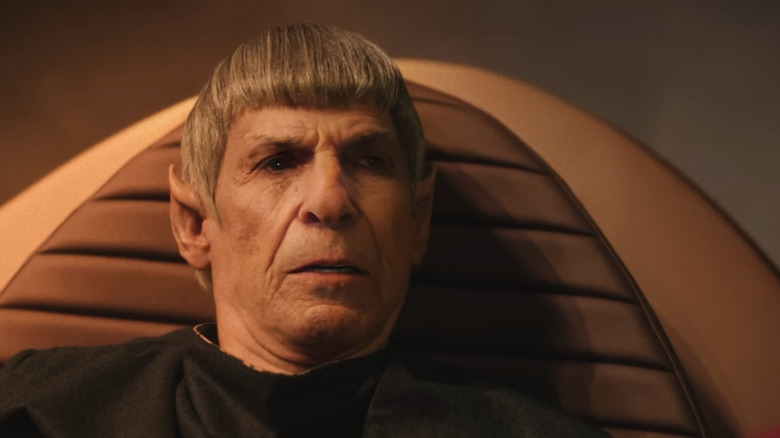
The badge, in a previous "765874" short, was actually Kirk's, recovered by Spock from Kirk's gravesite. While Spock was dying in the Kelvin timeline, he gave this badge to Yor. Yor, now a mysterious afterlife figure, was merely passing it back to Kirk. It's all very mysterious, but connects the disparate threads of "Star Trek" canon in a somewhat clever way.
Yor then seems to transport Kirk into a long and mysterious hallway, where he transforms into a younger version of himself, looking the way he did in the original "Star Trek." (Actor Sam Witwer stood in for Shatner in these scenes.) Kirk, now young, sees a version of himself the way he looked in "Star Trek II: The Wrath of Khan." The digital effects have an uncanny quality, but are impressive nonetheless. The Kirks vanish, and 1994-era Kirk enters a mysterious bedchamber on the planet New Vulcan (in the Kelvin universe) ... where Spock is laying on his deathbed. Kirk sits and holds his friend's hand as they watch the sunset. Spock presumably dies with Kirk at his side. One might assume that Kirk was merely an ethereal being in this sequence, so he is not stranded in the Kelvin timeline thereafter. Yor, it seems, was merely allowing the two to have a final moment together, something they never had in their respective timelines.
It's sweet enough, I suppose, and one may want to accept "765874" as canon, seeing as it was made with the participation of the Roddenberry camp, Nimoy's estate, and Shatner himself. Of course, if it is canon, then the Sorak character mentioned above was indeed Spock's son. In an early script for "Star Trek IV," it would have been revealed that Spock and Saavik had a child together, a fact that was reinforced in Josepha Sherman and Susan Shwartz 1999 novel "Vulcan's Heart."
The "765874" shorts are more experiments than legit "Star Trek" movies, though. They are obscurities for fans and SFX tech obsessives. On that level, they're kind of fun.
5 Star Trek Characters Who Disappeared Without Any Reason
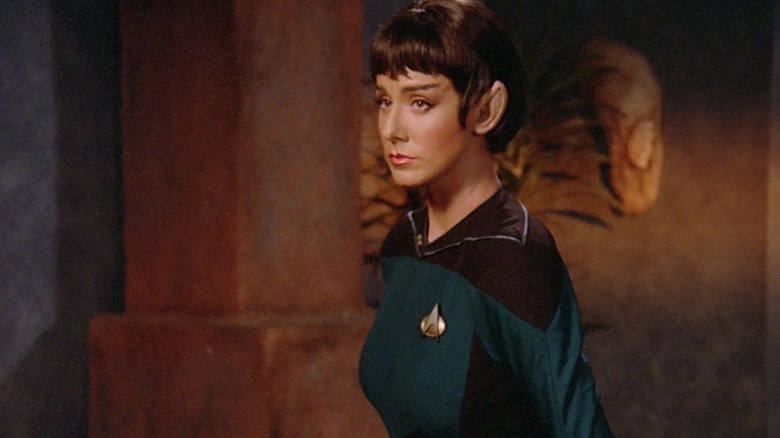
We may receive a commission on purchases made from links.
The "Star Trek" universe is vast and complicated. Most of the "Star Trek" shows to date take place on Federation vessels or stations staffed by career officers on specific assignments. The franchise largely revolves around managerial professionalism and workplace propriety. There is respect for the chain of command, and orders are given and followed as a matter of course. Starfleet is a military organization, but with its militant strictness devoted to exploration and diplomacy rather than combat and conquest. Ships are assigned to distant areas of space where they are tasked with examining a curious pulsar or, say, to a disease-ridden world in need of medicine. The bureaucracy works in "Star Trek," and individuals go where they are needed.
As such, when a minor character appears on "Star Trek," Trekkies assume that they merely arrived on the U.S.S. Enterprise (or Deep Space Nine, etc.) because they were needed there. An itinerant expert may be called in to complete a specific mission and then, once completed, they will merrily fly off to another. We understand that any character on "Star Trek" could be reassigned at any minute. So, when a minor character vanishes, it's safe to assume they experienced a career shift. Central characters only tend to stick around because a starship captain has assembled a senior staff they prefer ... and also because the actors involved in bringing them to life have signed long-term contracts.
But for those of us who like those supporting characters, a small word of explanation would have been nice. "She was transferred" is all that's really required. Below are five "Star Trek" characters that left a mark on the franchise, only to disappear without notice.
(Side note: Certain characters disappeared from the "Star Trek" franchise — from Yeoman Rand (Grace Lee Whitney) to Ensign Sonya Gomez (Lycia Naff) — only to re-emerge many years later. Those characters will be absent from this list.)
Robin Lefler

Ensign Robin Lefler was one of the first roles played by Ashley Judd, and the character only appeared in the episodes "Darmok" (September 30, 1991) and "The Game" (October 28, 1991). More than a background engineer, however, Lefler was a well-rounded, confident, even somewhat sassy character. She had little to do in "Darmok," but Lefler played a major role in "The Game," serving as a counterpart and ally to the visiting Wesley Crusher (Wil Wheaton). In "The Game," the entire crew of the Enterprise-D become addicted to a head-mounted, thought-controlled video game that gives them addictive hits of endorphins. Wesley, ever the nerd, refuses to try it, feeling its tranquilizing effect might be dangerous. He and Lefler test the game in a lab and find that it can alter a user's brain chemistry to make them more suggestible.
Robin Lefler was described as a mission specialist, and she was introduced in "The Game" dictating a numerical list of rules to live by. She explains that she has compiled a list of 102 axioms she calls Lefler's Laws and uses them as a guide to traverse life more easily. Ultimately, though, audiences only got to learn a few of the laws before the end of "The Game," although she did give a hard copy of them to Wesley as a souvenir. The two young officers parted with a solid friendship.
Sadly, that was the last anyone heard from Robin Lefler in the central "Star Trek" canon, although she would later reemerge in multiple non-canonical "Star Trek" novels, including in the novelization of "All Good Things...," the "Next Generation" finale. She also was one of the main characters in "Star Trek: New Frontier" by Peter David, a novel series that was envisioned as a fully-formed "Star Trek" spinoff set at the same time as "Next Generation" on a ship called the U.S.S. Excalibur. (Lefler was the director of operations on the Excalibur.)
Dr. Carol Marcus in Star Trek II: The Wrath of Khan
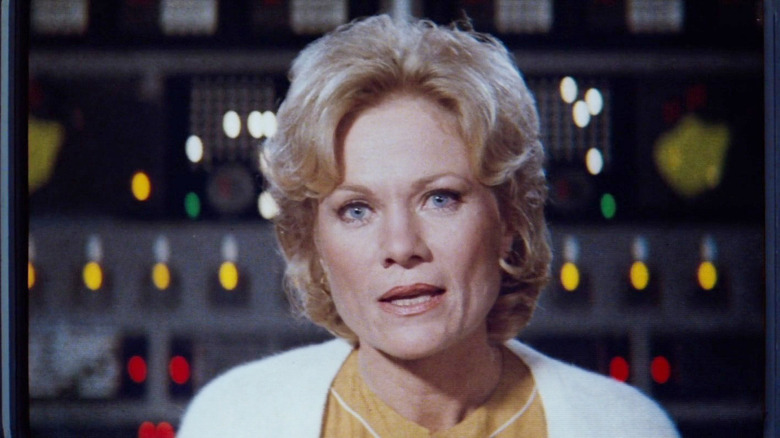
In "Star Trek II: The Wrath of Khan," Dr. Carol Marcus (played by Bibi Besch) was the inventor of the Genesis Wave, a specialize type of radiation that, when properly wielded, could terraform an entire planet in an instant, reconstituting the entire surface of a dead world into a verdant biome. She was also an old lover of Captain Kirk (William Shatner) and had been raising their son together without Kirk's knowledge. "Khan" is very much about how Kirk never actually faced the consequences of some of his more cavalier, youthful actions, and Dr. Marcus was there to remind him of the loves he left behind. Kirk and Dr. Marcus seem to reconcile by the end of the film and Kirk moves forward, knowing he'll have to communicate with his adult son David (Merritt Butrick).
David returns for "Star Trek III: The Search for Spock," but Dr. Marcus is curiously absent. Where did she go? Is Kirk content to lose contact again? It seems odd that she's never brought up again.
Dr. Carol Marcus in Star Trek Into Darkness
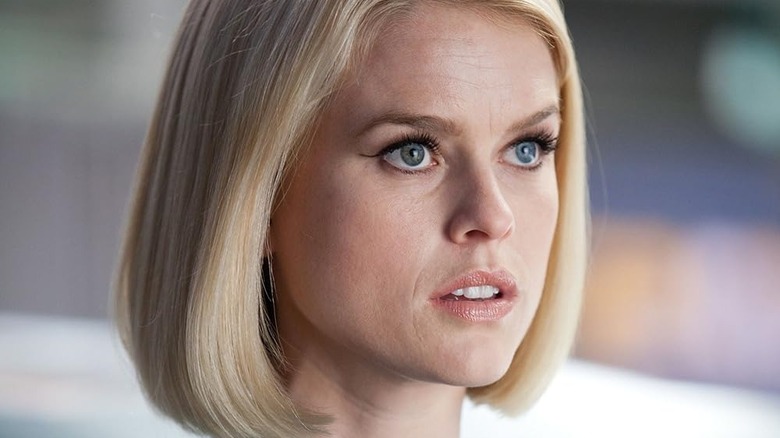
Strangely enough, Dr. Marcus vanishes after a single film in both the original and rebooted (aka Kelvin) timelines in the "Star Trek" franchise. In "Star Trek Into Darkness," Dr. Marcus (Alice Eve) was a weapons expert on board the Enterprise with a secret plan of her own; it seems that she is related to the wicked Admiral Alexander Marcus (Peter Weller) and initially boarded the ship under a pseudonym. Carol and Kirk (Chris Pine) go on to flirt a little before she joins the crew of the Enterprise at the end of the film.
It's weird, then, that she isn't even mentioned in "Star Trek Beyond," the sequel to "Into Darkness." Simon Pegg, who both co-wrote and starred in both of those films as the Enterprise's beloved chief engineer Montgomery "Scotty" Scott, has admitted that he simply couldn't think of anything for Carol to do.
Dr. Selar
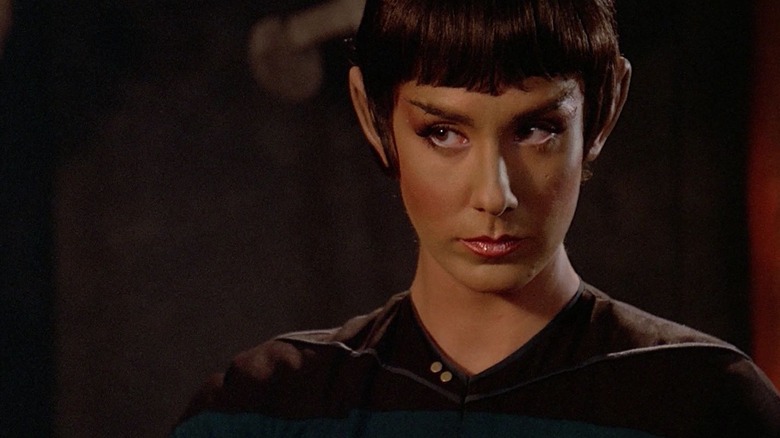
Dr. Selar (Susie Plakson) only appeared in a few scenes of the "Next Generation" episode "The Schizoid Man" (January 23, 1989), but she intrigued Trekkies everywhere. When "Next Generation" began, creator Gene Roddenberry wanted it to be deliberately unique from the original "Star Trek" and eschewed the presence of Vulcans on the bridge, feeling the species had been well explored already. Selar was one of the first Vulcans seen serving on the Enterprise-D, so Trekkies were naturally curious to learn more about her. It also helped that she was played by Plakson, who is a massively charismatic screen presence; even without moving much, Plakson gave Selar a great deal of character.
Selar is mentioned multiple times throughout "Next Generation," implying that she plays a vital role in the Enterprise's functions. Dr. Crusher (Gates McFadden) often casually mentions that Selar's off-screen running a spectral analysis or providing valuable consultations, although she never actually reappeared on screen. At least Trekkies got to see the return of Plakson, as she played the half-Klingon ambassador K'Ehleyr in two episodes of "Next Generation," a Q in "Star Trek: Voyager," and an Andorian in "Star Trek: Enterprise." Plakson knocked it out of the park each time.
Selar was given a full-blown subplot in A.C. Crispin's novel "Eyes of the Beholders." Also, like Robin Lefler, Selar was eventually reassigned to the U.S.S. Excalibur in the "New Frontier" book series. She served as that ship's chief medical officer. Author Peter David was very good about gathering together all the supporting players that Trekkies liked.
Ari bn Bem
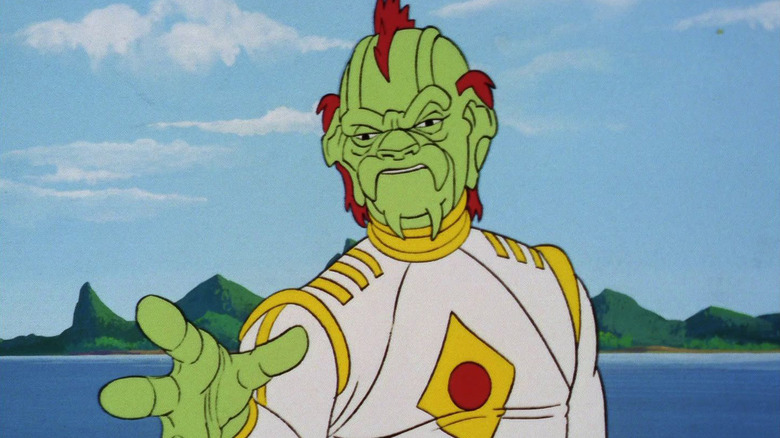
Many episodes of "Star Trek" featured notable guest stars who were only ever designed to appear once. For these episodes, the personal dramas of the main cast would temporarily take a backseat so that audiences (and relieved writers) could explore a new perspective. Often the guest star would either have a mystery of their own that the main cast would solve or they would have an agenda — sometimes heroic, sometime villainous — that they eventually revealed. Then, once the mystery was solved, the guest would move on, either happy to begin a new assignment or unhappily thrown in the brig. The really interesting guests would return in later episodes.
Bem (James Doohan) was a fascinatingly strange character that, one might assume, the makers of "Star Trek: The Animated Series" would want to revisit again and again, largely because he was only capable of being realized in animation. Bem was sent to the Enterprise to secretly observe the ship's crew and determine if they were ready to engage in contact with his species. He spoke in a broken fashion and seemed to know something Captain Kirk (William Shatner) didn't. Eventually, Bem's secret was revealed: he is a colony being. That is, individual parts of his body can detach and hover through the air. His legs can walk on their own and his head can be knocked from his shoulders.
The concept is strange, even for "Star Trek," but exploring Bem's biological oddities was never completed. Bem completed his mission, but the Enterprise never stayed in contact. Trekkies wouldn't see another member of Bem's species until "Star Trek: Lower Decks" 50 years later.
Bem wasn't super-important to the Enterprise and his story concluded, yet his disappearance is upsetting to me personally, as I would have loved to see him persist as a supporting player. The weirder the aliens are, the better.



